Exploring Wearable Sensor Technology: A Detailed Literature Review
VerifiedAdded on 2023/04/17
|54
|11470
|146
Literature Review
AI Summary
This literature review provides a comprehensive overview of wearable sensor technology, tracing its development from early applications in the Apollo space program to modern uses in healthcare and fitness. It examines various wearable devices like FitBit Surge, Gymwatch Fitness Tracker, iTBra, Aira sensor, Quell Relief, QardioCore, Embrace Watch, HealthPatch MD, and Novocure, detailing their functionalities and impact. The review also discusses the advantages of wearable sensors in monitoring physiological parameters, enabling early detection of health changes, and improving patient care. It further explores the future trends in wearable technology, emphasizing the potential for smaller, cheaper, and more versatile sensors. The review concludes by identifying open research problems and proposing novel sensing architectures for future development and applications in the field.
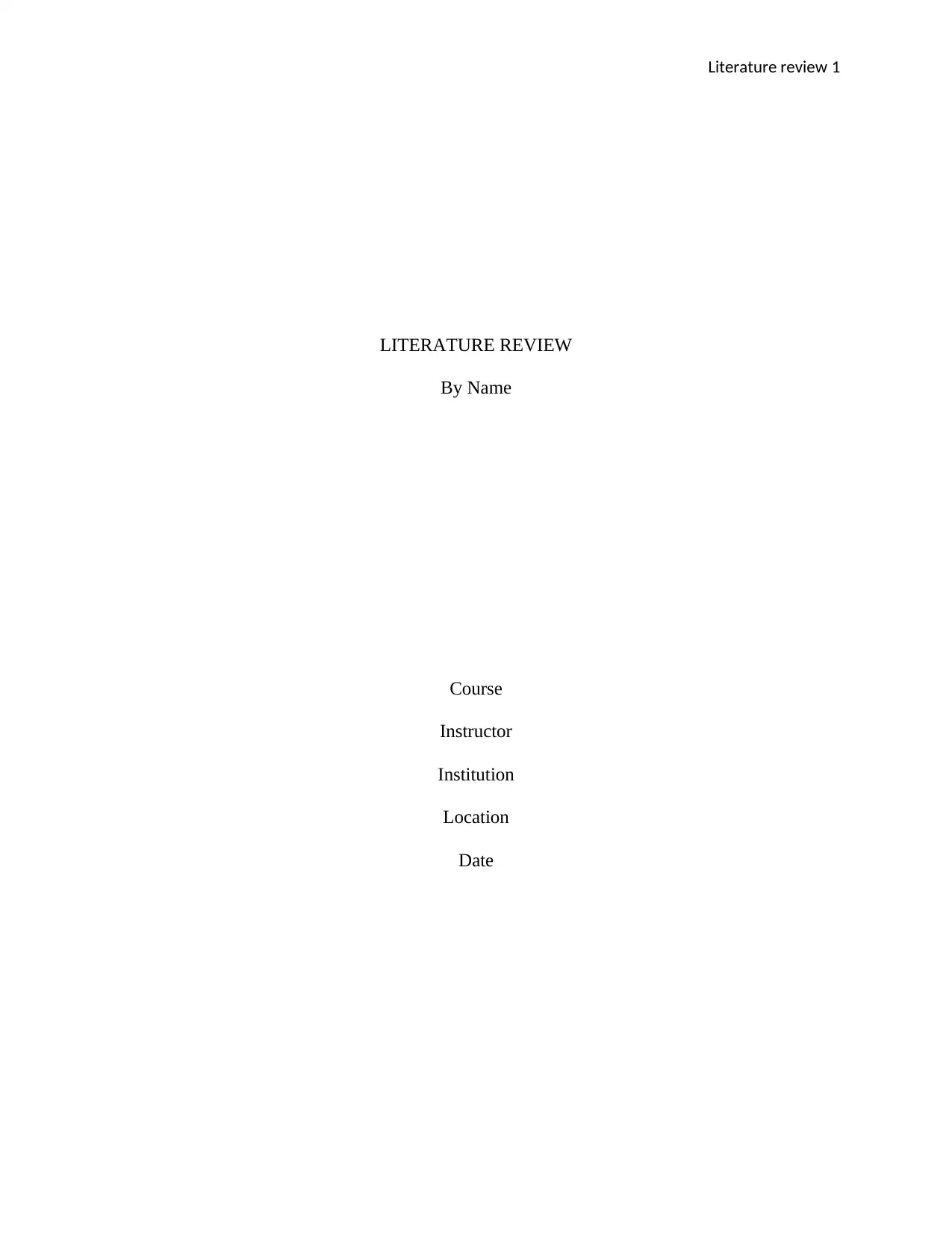
Literature review 1
LITERATURE REVIEW
By Name
Course
Instructor
Institution
Location
Date
LITERATURE REVIEW
By Name
Course
Instructor
Institution
Location
Date
Paraphrase This Document
Need a fresh take? Get an instant paraphrase of this document with our AI Paraphraser
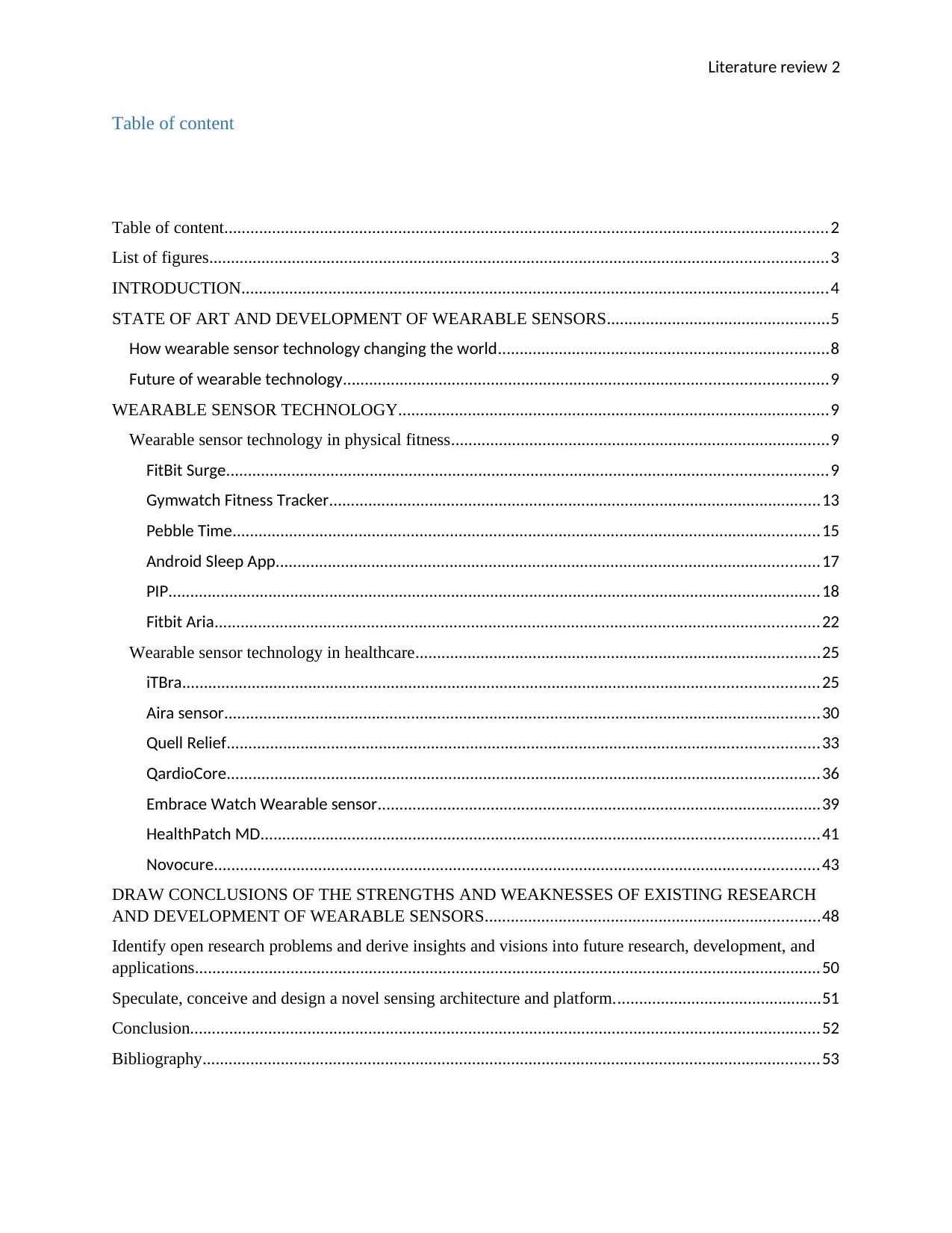
Literature review 2
Table of content
Table of content...........................................................................................................................................2
List of figures..............................................................................................................................................3
INTRODUCTION.......................................................................................................................................4
STATE OF ART AND DEVELOPMENT OF WEARABLE SENSORS...................................................5
How wearable sensor technology changing the world............................................................................8
Future of wearable technology...............................................................................................................9
WEARABLE SENSOR TECHNOLOGY...................................................................................................9
Wearable sensor technology in physical fitness.......................................................................................9
FitBit Surge..........................................................................................................................................9
Gymwatch Fitness Tracker.................................................................................................................13
Pebble Time.......................................................................................................................................15
Android Sleep App.............................................................................................................................17
PIP......................................................................................................................................................18
Fitbit Aria...........................................................................................................................................22
Wearable sensor technology in healthcare.............................................................................................25
iTBra..................................................................................................................................................25
Aira sensor.........................................................................................................................................30
Quell Relief........................................................................................................................................33
QardioCore........................................................................................................................................36
Embrace Watch Wearable sensor......................................................................................................39
HealthPatch MD................................................................................................................................41
Novocure...........................................................................................................................................43
DRAW CONCLUSIONS OF THE STRENGTHS AND WEAKNESSES OF EXISTING RESEARCH
AND DEVELOPMENT OF WEARABLE SENSORS.............................................................................48
Identify open research problems and derive insights and visions into future research, development, and
applications................................................................................................................................................50
Speculate, conceive and design a novel sensing architecture and platform................................................51
Conclusion.................................................................................................................................................52
Bibliography..............................................................................................................................................53
Table of content
Table of content...........................................................................................................................................2
List of figures..............................................................................................................................................3
INTRODUCTION.......................................................................................................................................4
STATE OF ART AND DEVELOPMENT OF WEARABLE SENSORS...................................................5
How wearable sensor technology changing the world............................................................................8
Future of wearable technology...............................................................................................................9
WEARABLE SENSOR TECHNOLOGY...................................................................................................9
Wearable sensor technology in physical fitness.......................................................................................9
FitBit Surge..........................................................................................................................................9
Gymwatch Fitness Tracker.................................................................................................................13
Pebble Time.......................................................................................................................................15
Android Sleep App.............................................................................................................................17
PIP......................................................................................................................................................18
Fitbit Aria...........................................................................................................................................22
Wearable sensor technology in healthcare.............................................................................................25
iTBra..................................................................................................................................................25
Aira sensor.........................................................................................................................................30
Quell Relief........................................................................................................................................33
QardioCore........................................................................................................................................36
Embrace Watch Wearable sensor......................................................................................................39
HealthPatch MD................................................................................................................................41
Novocure...........................................................................................................................................43
DRAW CONCLUSIONS OF THE STRENGTHS AND WEAKNESSES OF EXISTING RESEARCH
AND DEVELOPMENT OF WEARABLE SENSORS.............................................................................48
Identify open research problems and derive insights and visions into future research, development, and
applications................................................................................................................................................50
Speculate, conceive and design a novel sensing architecture and platform................................................51
Conclusion.................................................................................................................................................52
Bibliography..............................................................................................................................................53
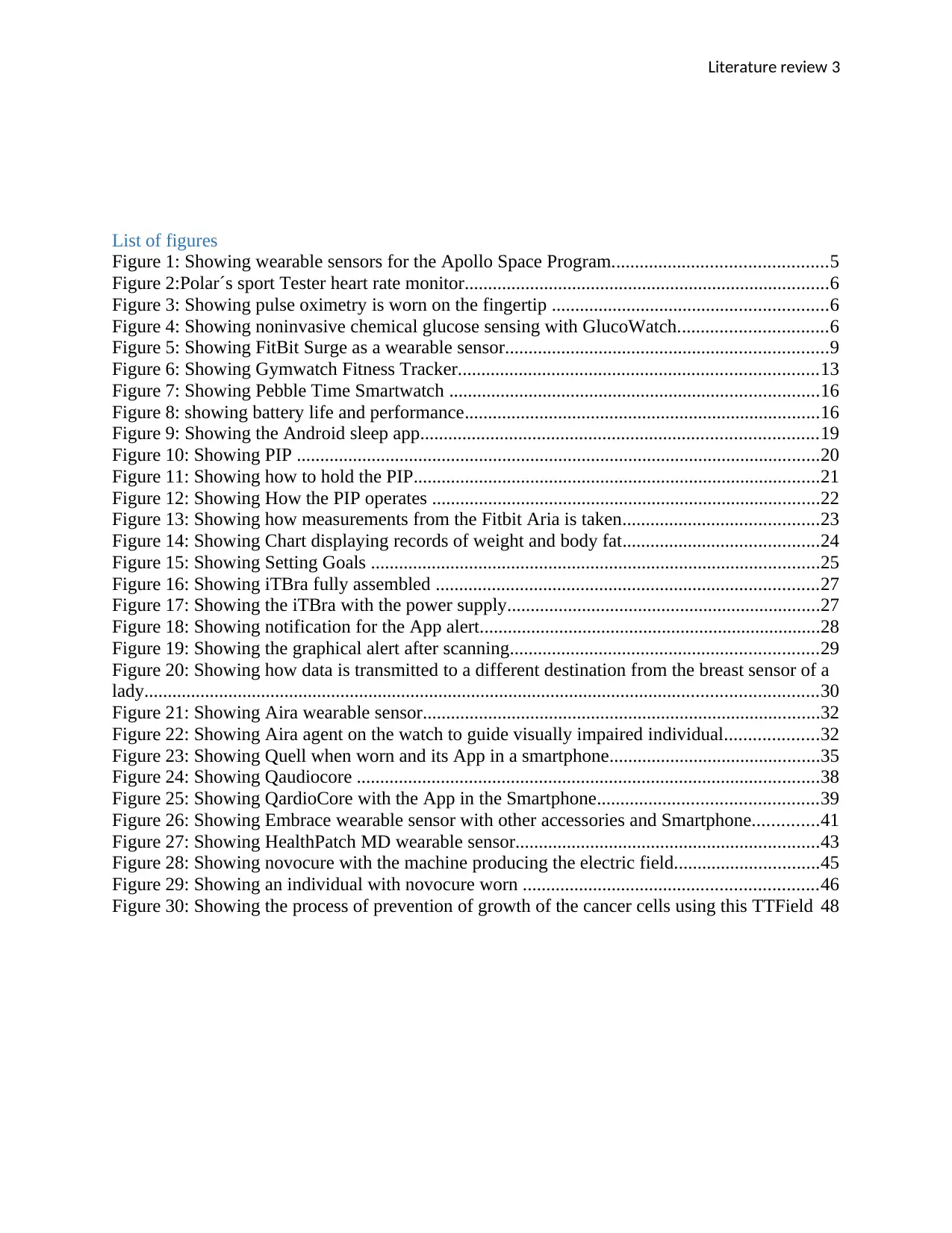
Literature review 3
List of figures
Figure 1: Showing wearable sensors for the Apollo Space Program..............................................5
Figure 2:Polar´s sport Tester heart rate monitor..............................................................................6
Figure 3: Showing pulse oximetry is worn on the fingertip ...........................................................6
Figure 4: Showing noninvasive chemical glucose sensing with GlucoWatch................................6
Figure 5: Showing FitBit Surge as a wearable sensor.....................................................................9
Figure 6: Showing Gymwatch Fitness Tracker.............................................................................13
Figure 7: Showing Pebble Time Smartwatch ...............................................................................16
Figure 8: showing battery life and performance............................................................................16
Figure 9: Showing the Android sleep app.....................................................................................19
Figure 10: Showing PIP ................................................................................................................20
Figure 11: Showing how to hold the PIP.......................................................................................21
Figure 12: Showing How the PIP operates ...................................................................................22
Figure 13: Showing how measurements from the Fitbit Aria is taken..........................................23
Figure 14: Showing Chart displaying records of weight and body fat..........................................24
Figure 15: Showing Setting Goals ................................................................................................25
Figure 16: Showing iTBra fully assembled ..................................................................................27
Figure 17: Showing the iTBra with the power supply...................................................................27
Figure 18: Showing notification for the App alert.........................................................................28
Figure 19: Showing the graphical alert after scanning..................................................................29
Figure 20: Showing how data is transmitted to a different destination from the breast sensor of a
lady................................................................................................................................................30
Figure 21: Showing Aira wearable sensor.....................................................................................32
Figure 22: Showing Aira agent on the watch to guide visually impaired individual....................32
Figure 23: Showing Quell when worn and its App in a smartphone.............................................35
Figure 24: Showing Qaudiocore ...................................................................................................38
Figure 25: Showing QardioCore with the App in the Smartphone...............................................39
Figure 26: Showing Embrace wearable sensor with other accessories and Smartphone..............41
Figure 27: Showing HealthPatch MD wearable sensor.................................................................43
Figure 28: Showing novocure with the machine producing the electric field...............................45
Figure 29: Showing an individual with novocure worn ...............................................................46
Figure 30: Showing the process of prevention of growth of the cancer cells using this TTField 48
List of figures
Figure 1: Showing wearable sensors for the Apollo Space Program..............................................5
Figure 2:Polar´s sport Tester heart rate monitor..............................................................................6
Figure 3: Showing pulse oximetry is worn on the fingertip ...........................................................6
Figure 4: Showing noninvasive chemical glucose sensing with GlucoWatch................................6
Figure 5: Showing FitBit Surge as a wearable sensor.....................................................................9
Figure 6: Showing Gymwatch Fitness Tracker.............................................................................13
Figure 7: Showing Pebble Time Smartwatch ...............................................................................16
Figure 8: showing battery life and performance............................................................................16
Figure 9: Showing the Android sleep app.....................................................................................19
Figure 10: Showing PIP ................................................................................................................20
Figure 11: Showing how to hold the PIP.......................................................................................21
Figure 12: Showing How the PIP operates ...................................................................................22
Figure 13: Showing how measurements from the Fitbit Aria is taken..........................................23
Figure 14: Showing Chart displaying records of weight and body fat..........................................24
Figure 15: Showing Setting Goals ................................................................................................25
Figure 16: Showing iTBra fully assembled ..................................................................................27
Figure 17: Showing the iTBra with the power supply...................................................................27
Figure 18: Showing notification for the App alert.........................................................................28
Figure 19: Showing the graphical alert after scanning..................................................................29
Figure 20: Showing how data is transmitted to a different destination from the breast sensor of a
lady................................................................................................................................................30
Figure 21: Showing Aira wearable sensor.....................................................................................32
Figure 22: Showing Aira agent on the watch to guide visually impaired individual....................32
Figure 23: Showing Quell when worn and its App in a smartphone.............................................35
Figure 24: Showing Qaudiocore ...................................................................................................38
Figure 25: Showing QardioCore with the App in the Smartphone...............................................39
Figure 26: Showing Embrace wearable sensor with other accessories and Smartphone..............41
Figure 27: Showing HealthPatch MD wearable sensor.................................................................43
Figure 28: Showing novocure with the machine producing the electric field...............................45
Figure 29: Showing an individual with novocure worn ...............................................................46
Figure 30: Showing the process of prevention of growth of the cancer cells using this TTField 48
⊘ This is a preview!⊘
Do you want full access?
Subscribe today to unlock all pages.

Trusted by 1+ million students worldwide

Literature review 4
INTRODUCTION
Wearable Sensing Technologies are basically employed in smart electronics (these are
electronics with microcontrollers) which can be used in several areas not limited to cloths put on
the body, accessories or even implants. Wearable gadgets like activity tracker are the good
prototype of the internet of things (IoT) because the electronics, sensors and software are
employed as the effectors which make the object to exchange data via the internet with the
operator, manufactures as well as other connected devices without human intervention at all.
Therefore this technology has a wide range of application that grows as the field expands over
time. It occurs prominently in electronics consumers having the popularization of activity
tracker, smartwatch and physiological vital sign parameter.
Wearable technology is not only employed commercially but also employed in other
sectors like healthcare, navigation systems, and advance textile among others. This sensing
technology has for sure expands and there it is hence categorized into some subcategory which
includes sensing employed in medical application and sensing employed in general fitness. But
on the present life most people enamored with several fashionable devices which can be worn on
body parts like ankle, shoulder, wrist among other parts. Today wearable sensing technology and
platform is the most sophisticated and most pioneering advancement in the sector of technology
since this technology advances sensor as well as wireless technology.
As the name suggests these are basically sensors which are worn in the body parts and
some of the examples of these sensors may include Smartwatches like android wear, apple watch
and Pebble watches which are all employed for physical fitness. The ones which are employed
in healthcare includes iTBra sensors which are basically employed in detecting breast cancers
like ladies, KardiaMobile and KardiaBand employed for checking irregular heart activated by
INTRODUCTION
Wearable Sensing Technologies are basically employed in smart electronics (these are
electronics with microcontrollers) which can be used in several areas not limited to cloths put on
the body, accessories or even implants. Wearable gadgets like activity tracker are the good
prototype of the internet of things (IoT) because the electronics, sensors and software are
employed as the effectors which make the object to exchange data via the internet with the
operator, manufactures as well as other connected devices without human intervention at all.
Therefore this technology has a wide range of application that grows as the field expands over
time. It occurs prominently in electronics consumers having the popularization of activity
tracker, smartwatch and physiological vital sign parameter.
Wearable technology is not only employed commercially but also employed in other
sectors like healthcare, navigation systems, and advance textile among others. This sensing
technology has for sure expands and there it is hence categorized into some subcategory which
includes sensing employed in medical application and sensing employed in general fitness. But
on the present life most people enamored with several fashionable devices which can be worn on
body parts like ankle, shoulder, wrist among other parts. Today wearable sensing technology and
platform is the most sophisticated and most pioneering advancement in the sector of technology
since this technology advances sensor as well as wireless technology.
As the name suggests these are basically sensors which are worn in the body parts and
some of the examples of these sensors may include Smartwatches like android wear, apple watch
and Pebble watches which are all employed for physical fitness. The ones which are employed
in healthcare includes iTBra sensors which are basically employed in detecting breast cancers
like ladies, KardiaMobile and KardiaBand employed for checking irregular heart activated by
Paraphrase This Document
Need a fresh take? Get an instant paraphrase of this document with our AI Paraphraser
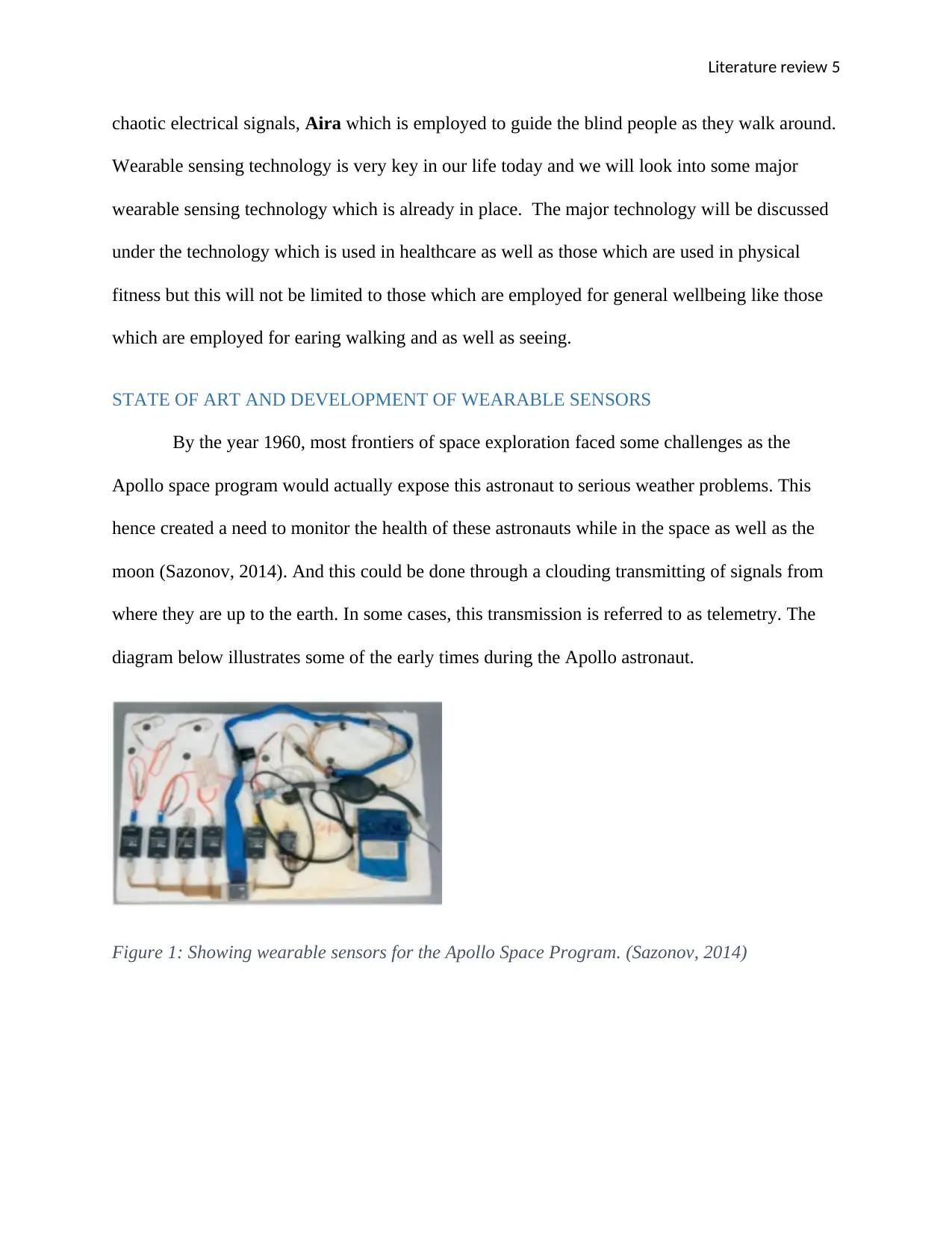
Literature review 5
chaotic electrical signals, Aira which is employed to guide the blind people as they walk around.
Wearable sensing technology is very key in our life today and we will look into some major
wearable sensing technology which is already in place. The major technology will be discussed
under the technology which is used in healthcare as well as those which are used in physical
fitness but this will not be limited to those which are employed for general wellbeing like those
which are employed for earing walking and as well as seeing.
STATE OF ART AND DEVELOPMENT OF WEARABLE SENSORS
By the year 1960, most frontiers of space exploration faced some challenges as the
Apollo space program would actually expose this astronaut to serious weather problems. This
hence created a need to monitor the health of these astronauts while in the space as well as the
moon (Sazonov, 2014). And this could be done through a clouding transmitting of signals from
where they are up to the earth. In some cases, this transmission is referred to as telemetry. The
diagram below illustrates some of the early times during the Apollo astronaut.
Figure 1: Showing wearable sensors for the Apollo Space Program. (Sazonov, 2014)
chaotic electrical signals, Aira which is employed to guide the blind people as they walk around.
Wearable sensing technology is very key in our life today and we will look into some major
wearable sensing technology which is already in place. The major technology will be discussed
under the technology which is used in healthcare as well as those which are used in physical
fitness but this will not be limited to those which are employed for general wellbeing like those
which are employed for earing walking and as well as seeing.
STATE OF ART AND DEVELOPMENT OF WEARABLE SENSORS
By the year 1960, most frontiers of space exploration faced some challenges as the
Apollo space program would actually expose this astronaut to serious weather problems. This
hence created a need to monitor the health of these astronauts while in the space as well as the
moon (Sazonov, 2014). And this could be done through a clouding transmitting of signals from
where they are up to the earth. In some cases, this transmission is referred to as telemetry. The
diagram below illustrates some of the early times during the Apollo astronaut.
Figure 1: Showing wearable sensors for the Apollo Space Program. (Sazonov, 2014)

Literature review 6
Figure 2:Polar´s sport Tester heart rate monitor (Sazonov, 2014).
Figure 3: Showing pulse oximetry is worn on the fingertip (Sazonov, 2014).
Figure 4: Showing noninvasive chemical glucose sensing with GlucoWatch (Sazonov, 2014).
Figure 2:Polar´s sport Tester heart rate monitor (Sazonov, 2014).
Figure 3: Showing pulse oximetry is worn on the fingertip (Sazonov, 2014).
Figure 4: Showing noninvasive chemical glucose sensing with GlucoWatch (Sazonov, 2014).
⊘ This is a preview!⊘
Do you want full access?
Subscribe today to unlock all pages.

Trusted by 1+ million students worldwide
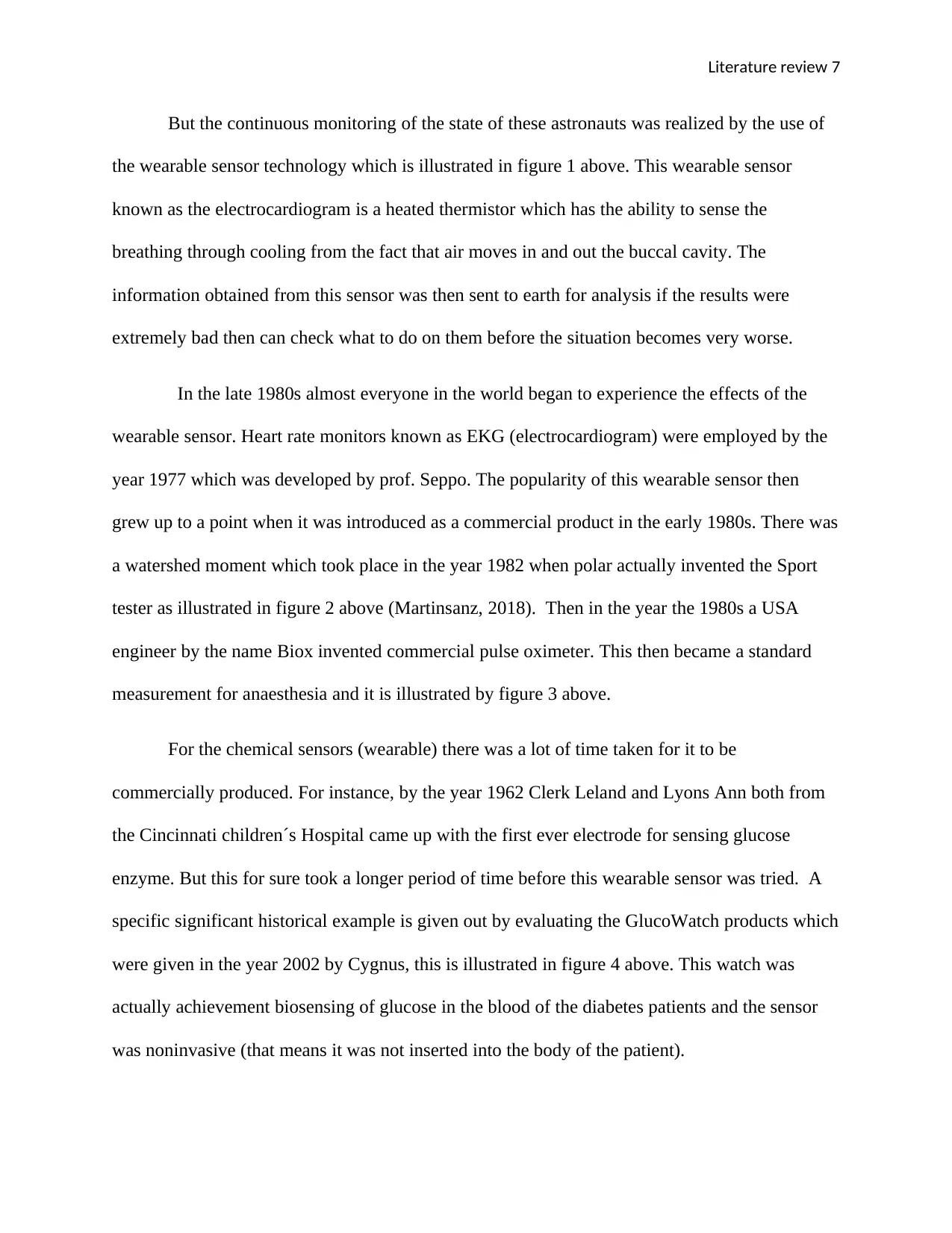
Literature review 7
But the continuous monitoring of the state of these astronauts was realized by the use of
the wearable sensor technology which is illustrated in figure 1 above. This wearable sensor
known as the electrocardiogram is a heated thermistor which has the ability to sense the
breathing through cooling from the fact that air moves in and out the buccal cavity. The
information obtained from this sensor was then sent to earth for analysis if the results were
extremely bad then can check what to do on them before the situation becomes very worse.
In the late 1980s almost everyone in the world began to experience the effects of the
wearable sensor. Heart rate monitors known as EKG (electrocardiogram) were employed by the
year 1977 which was developed by prof. Seppo. The popularity of this wearable sensor then
grew up to a point when it was introduced as a commercial product in the early 1980s. There was
a watershed moment which took place in the year 1982 when polar actually invented the Sport
tester as illustrated in figure 2 above (Martinsanz, 2018). Then in the year the 1980s a USA
engineer by the name Biox invented commercial pulse oximeter. This then became a standard
measurement for anaesthesia and it is illustrated by figure 3 above.
For the chemical sensors (wearable) there was a lot of time taken for it to be
commercially produced. For instance, by the year 1962 Clerk Leland and Lyons Ann both from
the Cincinnati children´s Hospital came up with the first ever electrode for sensing glucose
enzyme. But this for sure took a longer period of time before this wearable sensor was tried. A
specific significant historical example is given out by evaluating the GlucoWatch products which
were given in the year 2002 by Cygnus, this is illustrated in figure 4 above. This watch was
actually achievement biosensing of glucose in the blood of the diabetes patients and the sensor
was noninvasive (that means it was not inserted into the body of the patient).
But the continuous monitoring of the state of these astronauts was realized by the use of
the wearable sensor technology which is illustrated in figure 1 above. This wearable sensor
known as the electrocardiogram is a heated thermistor which has the ability to sense the
breathing through cooling from the fact that air moves in and out the buccal cavity. The
information obtained from this sensor was then sent to earth for analysis if the results were
extremely bad then can check what to do on them before the situation becomes very worse.
In the late 1980s almost everyone in the world began to experience the effects of the
wearable sensor. Heart rate monitors known as EKG (electrocardiogram) were employed by the
year 1977 which was developed by prof. Seppo. The popularity of this wearable sensor then
grew up to a point when it was introduced as a commercial product in the early 1980s. There was
a watershed moment which took place in the year 1982 when polar actually invented the Sport
tester as illustrated in figure 2 above (Martinsanz, 2018). Then in the year the 1980s a USA
engineer by the name Biox invented commercial pulse oximeter. This then became a standard
measurement for anaesthesia and it is illustrated by figure 3 above.
For the chemical sensors (wearable) there was a lot of time taken for it to be
commercially produced. For instance, by the year 1962 Clerk Leland and Lyons Ann both from
the Cincinnati children´s Hospital came up with the first ever electrode for sensing glucose
enzyme. But this for sure took a longer period of time before this wearable sensor was tried. A
specific significant historical example is given out by evaluating the GlucoWatch products which
were given in the year 2002 by Cygnus, this is illustrated in figure 4 above. This watch was
actually achievement biosensing of glucose in the blood of the diabetes patients and the sensor
was noninvasive (that means it was not inserted into the body of the patient).
Paraphrase This Document
Need a fresh take? Get an instant paraphrase of this document with our AI Paraphraser

Literature review 8
Basically, this sensor used 2 gel pads which were put on the skin of the patient which
were cycled with DC potential to do the extraction through inverse iontophoresis. The Watch
like gadget uses a current density of about 0.5 mA cm -2 to do the extraction of glucose and
intestinal fluid mostly via preexisting pathways in the hair follicles and sweat duct (commonly
referred to as stratum corneum), this inverse iontophoresis produces an electro-osmosis
movement of the intestinal fluid via paracellular pathways. And this is only possible since the
plasma membrane charged negatively hence promoting the flow of the electroosmotic of sodium
ions. And the DC potential was inversely cycled for every 10 minutes between the pads of the
gel to help avoid the increase of the pH at the electrode which harms the skin.
Actually, as we know today, wearable sensors have really dominated the commercial
market especially the wristwatch sensors which are employed in different applications. Some
example of these wrist watches includes Medical patches, FitBit and Apple Watch used in the
healthcare. It worth to note that nowadays wearable sensors are simply optical and electrical
measurement on the skin of which most of them have been available for several years ago.
How wearable sensor technology changing the world
The capacity to essentially monitor and track a persistent stream of physiologic
parameters with gadgets just like the MultiSense “Band-aid” sensor in all potential settings — in
specific in settings with restricted health care resources — permits for markedly improved care
of patients and improved safety of health care specialists (Martinsanz, 2018). By incorporating
advanced, real-time, individualized information analytics with these data streams, changes in
patient status can be detected much earlier than regular and health care providers alerted
automatically with actionable data. Over the long run, these advances will permit for the
rearranged screening and earlier diagnosis of huge populations of at-risk people.
Basically, this sensor used 2 gel pads which were put on the skin of the patient which
were cycled with DC potential to do the extraction through inverse iontophoresis. The Watch
like gadget uses a current density of about 0.5 mA cm -2 to do the extraction of glucose and
intestinal fluid mostly via preexisting pathways in the hair follicles and sweat duct (commonly
referred to as stratum corneum), this inverse iontophoresis produces an electro-osmosis
movement of the intestinal fluid via paracellular pathways. And this is only possible since the
plasma membrane charged negatively hence promoting the flow of the electroosmotic of sodium
ions. And the DC potential was inversely cycled for every 10 minutes between the pads of the
gel to help avoid the increase of the pH at the electrode which harms the skin.
Actually, as we know today, wearable sensors have really dominated the commercial
market especially the wristwatch sensors which are employed in different applications. Some
example of these wrist watches includes Medical patches, FitBit and Apple Watch used in the
healthcare. It worth to note that nowadays wearable sensors are simply optical and electrical
measurement on the skin of which most of them have been available for several years ago.
How wearable sensor technology changing the world
The capacity to essentially monitor and track a persistent stream of physiologic
parameters with gadgets just like the MultiSense “Band-aid” sensor in all potential settings — in
specific in settings with restricted health care resources — permits for markedly improved care
of patients and improved safety of health care specialists (Martinsanz, 2018). By incorporating
advanced, real-time, individualized information analytics with these data streams, changes in
patient status can be detected much earlier than regular and health care providers alerted
automatically with actionable data. Over the long run, these advances will permit for the
rearranged screening and earlier diagnosis of huge populations of at-risk people.
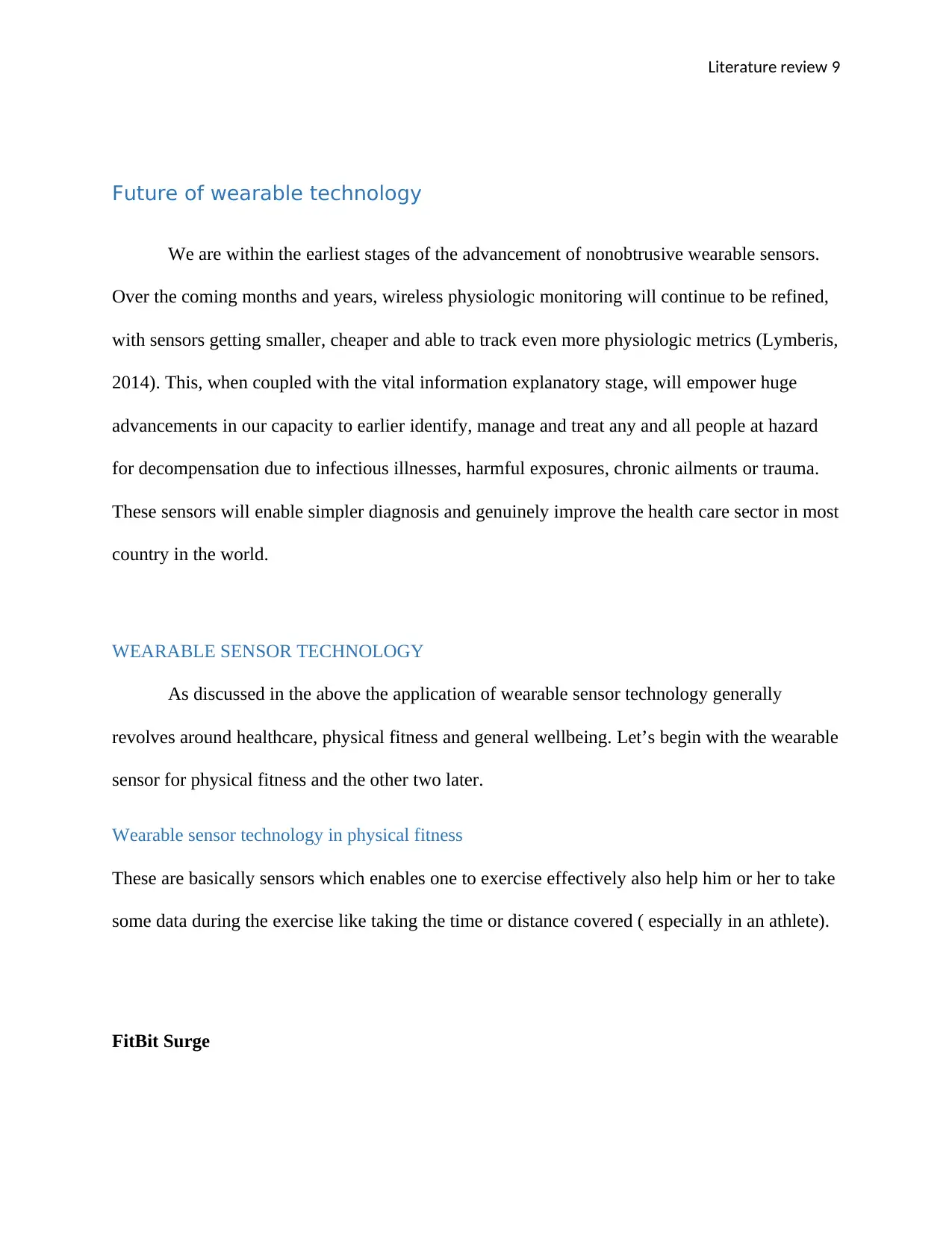
Literature review 9
Future of wearable technology
We are within the earliest stages of the advancement of nonobtrusive wearable sensors.
Over the coming months and years, wireless physiologic monitoring will continue to be refined,
with sensors getting smaller, cheaper and able to track even more physiologic metrics (Lymberis,
2014). This, when coupled with the vital information explanatory stage, will empower huge
advancements in our capacity to earlier identify, manage and treat any and all people at hazard
for decompensation due to infectious illnesses, harmful exposures, chronic ailments or trauma.
These sensors will enable simpler diagnosis and genuinely improve the health care sector in most
country in the world.
WEARABLE SENSOR TECHNOLOGY
As discussed in the above the application of wearable sensor technology generally
revolves around healthcare, physical fitness and general wellbeing. Let’s begin with the wearable
sensor for physical fitness and the other two later.
Wearable sensor technology in physical fitness
These are basically sensors which enables one to exercise effectively also help him or her to take
some data during the exercise like taking the time or distance covered ( especially in an athlete).
FitBit Surge
Future of wearable technology
We are within the earliest stages of the advancement of nonobtrusive wearable sensors.
Over the coming months and years, wireless physiologic monitoring will continue to be refined,
with sensors getting smaller, cheaper and able to track even more physiologic metrics (Lymberis,
2014). This, when coupled with the vital information explanatory stage, will empower huge
advancements in our capacity to earlier identify, manage and treat any and all people at hazard
for decompensation due to infectious illnesses, harmful exposures, chronic ailments or trauma.
These sensors will enable simpler diagnosis and genuinely improve the health care sector in most
country in the world.
WEARABLE SENSOR TECHNOLOGY
As discussed in the above the application of wearable sensor technology generally
revolves around healthcare, physical fitness and general wellbeing. Let’s begin with the wearable
sensor for physical fitness and the other two later.
Wearable sensor technology in physical fitness
These are basically sensors which enables one to exercise effectively also help him or her to take
some data during the exercise like taking the time or distance covered ( especially in an athlete).
FitBit Surge
⊘ This is a preview!⊘
Do you want full access?
Subscribe today to unlock all pages.

Trusted by 1+ million students worldwide
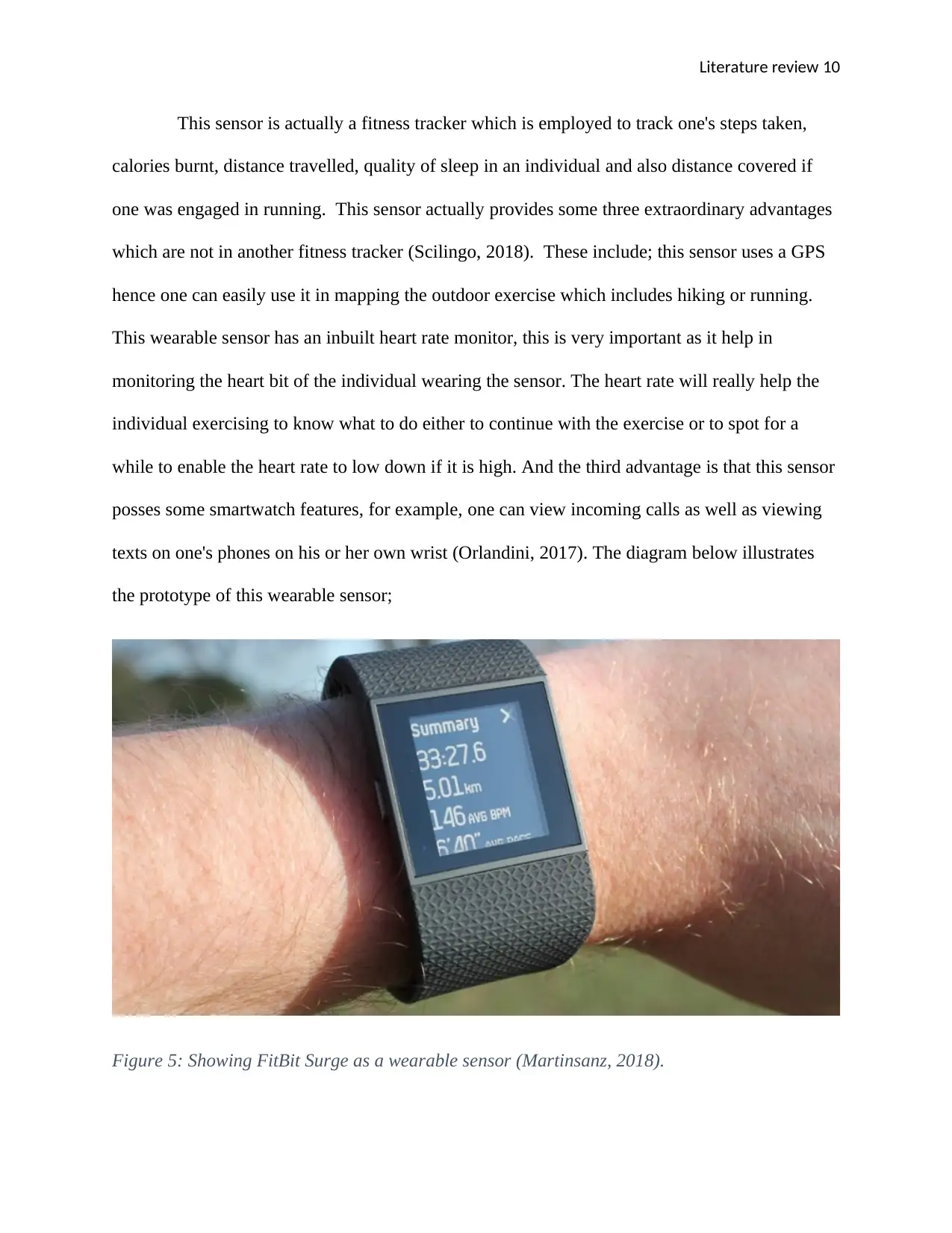
Literature review 10
This sensor is actually a fitness tracker which is employed to track one's steps taken,
calories burnt, distance travelled, quality of sleep in an individual and also distance covered if
one was engaged in running. This sensor actually provides some three extraordinary advantages
which are not in another fitness tracker (Scilingo, 2018). These include; this sensor uses a GPS
hence one can easily use it in mapping the outdoor exercise which includes hiking or running.
This wearable sensor has an inbuilt heart rate monitor, this is very important as it help in
monitoring the heart bit of the individual wearing the sensor. The heart rate will really help the
individual exercising to know what to do either to continue with the exercise or to spot for a
while to enable the heart rate to low down if it is high. And the third advantage is that this sensor
posses some smartwatch features, for example, one can view incoming calls as well as viewing
texts on one's phones on his or her own wrist (Orlandini, 2017). The diagram below illustrates
the prototype of this wearable sensor;
Figure 5: Showing FitBit Surge as a wearable sensor (Martinsanz, 2018).
This sensor is actually a fitness tracker which is employed to track one's steps taken,
calories burnt, distance travelled, quality of sleep in an individual and also distance covered if
one was engaged in running. This sensor actually provides some three extraordinary advantages
which are not in another fitness tracker (Scilingo, 2018). These include; this sensor uses a GPS
hence one can easily use it in mapping the outdoor exercise which includes hiking or running.
This wearable sensor has an inbuilt heart rate monitor, this is very important as it help in
monitoring the heart bit of the individual wearing the sensor. The heart rate will really help the
individual exercising to know what to do either to continue with the exercise or to spot for a
while to enable the heart rate to low down if it is high. And the third advantage is that this sensor
posses some smartwatch features, for example, one can view incoming calls as well as viewing
texts on one's phones on his or her own wrist (Orlandini, 2017). The diagram below illustrates
the prototype of this wearable sensor;
Figure 5: Showing FitBit Surge as a wearable sensor (Martinsanz, 2018).
Paraphrase This Document
Need a fresh take? Get an instant paraphrase of this document with our AI Paraphraser

Literature review 11
Data collections for FitBit Surge
FitBit Surge sensor actually calculates several parameters which this sensor is capable of
measuring, the following illustrates how this sensor is getting the information which it measures;
How FitBit sensor counts floors
This sensor employs an altimeter which is actually capable to detect when an individual
is moving down or up in elevation. This sensor is designed in a way that it will register a floor
when one wearing it climbs 10 feet at one time. But this sensor cannot calculate elevation gain
which is simulated from the inclined treadmill, StairMaster or even another motionless gadget
for exercise. This gadget employs the barometric pressure to sense a change in elevation and
hence needs that one has to physically elevate for it to correctly records the number of floors.
How FitBit Obtains distance covered.
FitBIt sensor obtains the distance covered through a very simple formula
D = LWS * NWS . . . . . . . . . . . . . . . . . . . . . . . . . . . . . . . . . . . . . . . . . . . . . . . . . . . . . . . . . . . . . 1
Where D is the distance covered by the one exercising, LWS is the length of the walking strides
and NWS is the number of walking stride made during the exercise. The same formula will be
employed to determine the distance covered when the individual exercising is running. When
this sensor is using GPS and one tracks one or more runs employing the onboard or even when
connected to the GPS then the data can be evaluated and then the strides of the individual
exercising can automatically update the running length of the strides.
How FitBit sensor obtain the calories burned during the exercise
Data collections for FitBit Surge
FitBit Surge sensor actually calculates several parameters which this sensor is capable of
measuring, the following illustrates how this sensor is getting the information which it measures;
How FitBit sensor counts floors
This sensor employs an altimeter which is actually capable to detect when an individual
is moving down or up in elevation. This sensor is designed in a way that it will register a floor
when one wearing it climbs 10 feet at one time. But this sensor cannot calculate elevation gain
which is simulated from the inclined treadmill, StairMaster or even another motionless gadget
for exercise. This gadget employs the barometric pressure to sense a change in elevation and
hence needs that one has to physically elevate for it to correctly records the number of floors.
How FitBit Obtains distance covered.
FitBIt sensor obtains the distance covered through a very simple formula
D = LWS * NWS . . . . . . . . . . . . . . . . . . . . . . . . . . . . . . . . . . . . . . . . . . . . . . . . . . . . . . . . . . . . . 1
Where D is the distance covered by the one exercising, LWS is the length of the walking strides
and NWS is the number of walking stride made during the exercise. The same formula will be
employed to determine the distance covered when the individual exercising is running. When
this sensor is using GPS and one tracks one or more runs employing the onboard or even when
connected to the GPS then the data can be evaluated and then the strides of the individual
exercising can automatically update the running length of the strides.
How FitBit sensor obtain the calories burned during the exercise
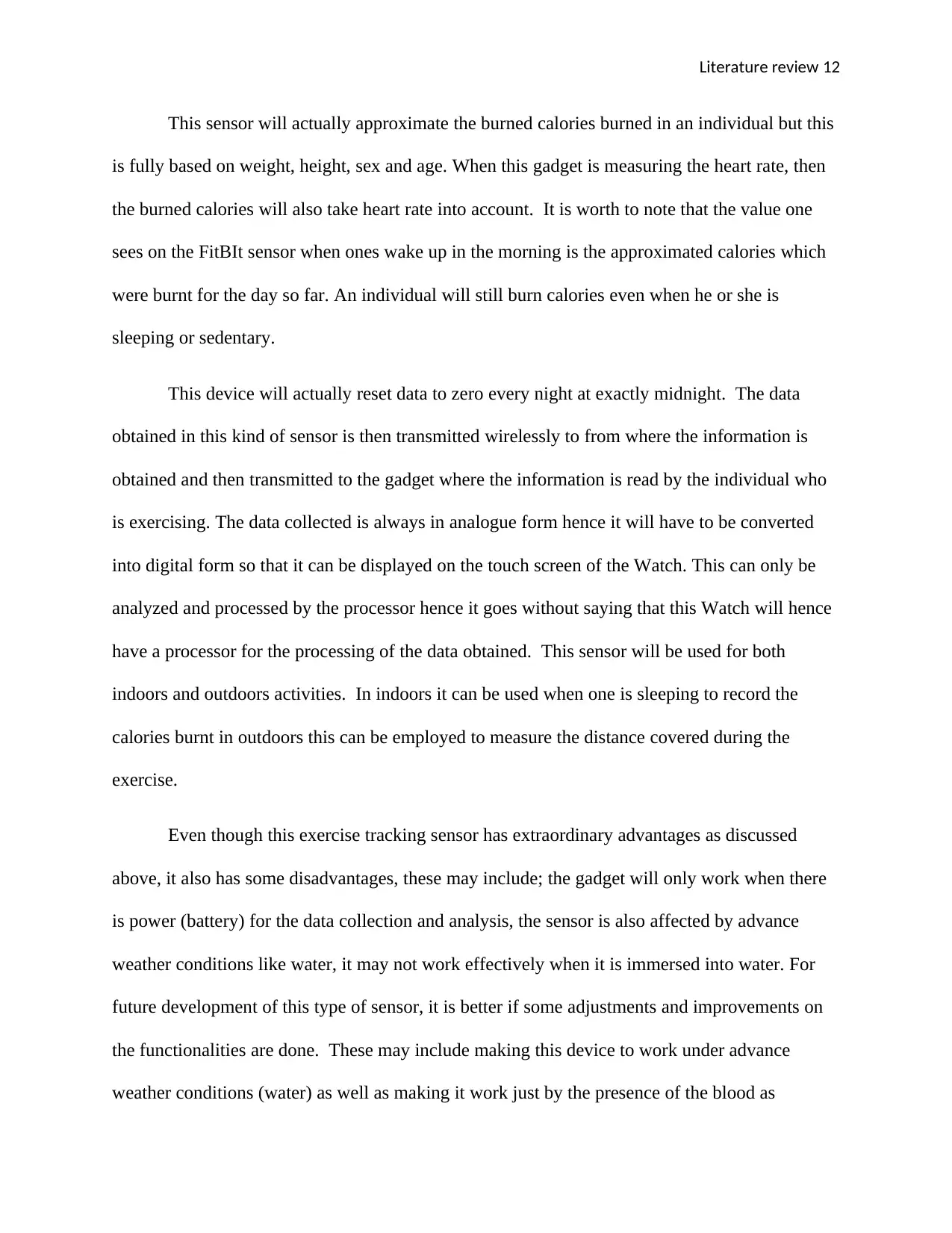
Literature review 12
This sensor will actually approximate the burned calories burned in an individual but this
is fully based on weight, height, sex and age. When this gadget is measuring the heart rate, then
the burned calories will also take heart rate into account. It is worth to note that the value one
sees on the FitBIt sensor when ones wake up in the morning is the approximated calories which
were burnt for the day so far. An individual will still burn calories even when he or she is
sleeping or sedentary.
This device will actually reset data to zero every night at exactly midnight. The data
obtained in this kind of sensor is then transmitted wirelessly to from where the information is
obtained and then transmitted to the gadget where the information is read by the individual who
is exercising. The data collected is always in analogue form hence it will have to be converted
into digital form so that it can be displayed on the touch screen of the Watch. This can only be
analyzed and processed by the processor hence it goes without saying that this Watch will hence
have a processor for the processing of the data obtained. This sensor will be used for both
indoors and outdoors activities. In indoors it can be used when one is sleeping to record the
calories burnt in outdoors this can be employed to measure the distance covered during the
exercise.
Even though this exercise tracking sensor has extraordinary advantages as discussed
above, it also has some disadvantages, these may include; the gadget will only work when there
is power (battery) for the data collection and analysis, the sensor is also affected by advance
weather conditions like water, it may not work effectively when it is immersed into water. For
future development of this type of sensor, it is better if some adjustments and improvements on
the functionalities are done. These may include making this device to work under advance
weather conditions (water) as well as making it work just by the presence of the blood as
This sensor will actually approximate the burned calories burned in an individual but this
is fully based on weight, height, sex and age. When this gadget is measuring the heart rate, then
the burned calories will also take heart rate into account. It is worth to note that the value one
sees on the FitBIt sensor when ones wake up in the morning is the approximated calories which
were burnt for the day so far. An individual will still burn calories even when he or she is
sleeping or sedentary.
This device will actually reset data to zero every night at exactly midnight. The data
obtained in this kind of sensor is then transmitted wirelessly to from where the information is
obtained and then transmitted to the gadget where the information is read by the individual who
is exercising. The data collected is always in analogue form hence it will have to be converted
into digital form so that it can be displayed on the touch screen of the Watch. This can only be
analyzed and processed by the processor hence it goes without saying that this Watch will hence
have a processor for the processing of the data obtained. This sensor will be used for both
indoors and outdoors activities. In indoors it can be used when one is sleeping to record the
calories burnt in outdoors this can be employed to measure the distance covered during the
exercise.
Even though this exercise tracking sensor has extraordinary advantages as discussed
above, it also has some disadvantages, these may include; the gadget will only work when there
is power (battery) for the data collection and analysis, the sensor is also affected by advance
weather conditions like water, it may not work effectively when it is immersed into water. For
future development of this type of sensor, it is better if some adjustments and improvements on
the functionalities are done. These may include making this device to work under advance
weather conditions (water) as well as making it work just by the presence of the blood as
⊘ This is a preview!⊘
Do you want full access?
Subscribe today to unlock all pages.

Trusted by 1+ million students worldwide
1 out of 54
Your All-in-One AI-Powered Toolkit for Academic Success.
+13062052269
info@desklib.com
Available 24*7 on WhatsApp / Email
![[object Object]](/_next/static/media/star-bottom.7253800d.svg)
Unlock your academic potential
Copyright © 2020–2025 A2Z Services. All Rights Reserved. Developed and managed by ZUCOL.